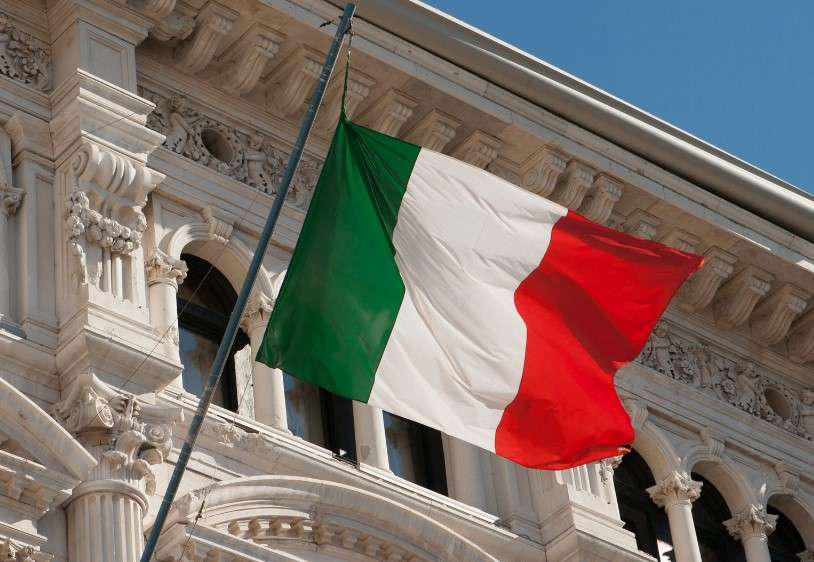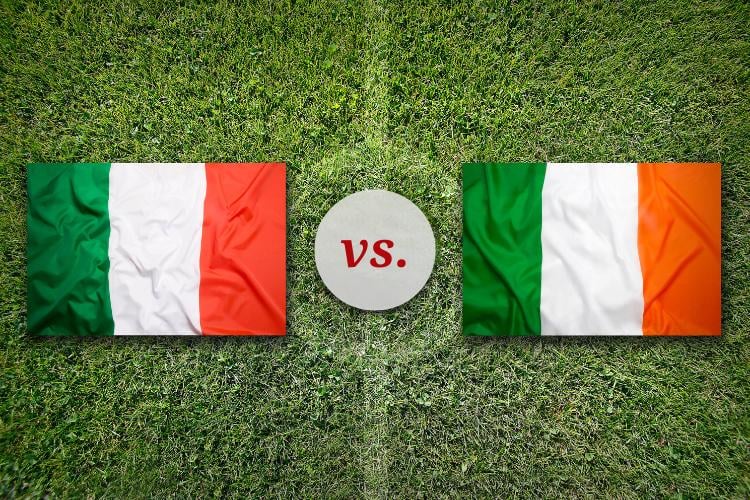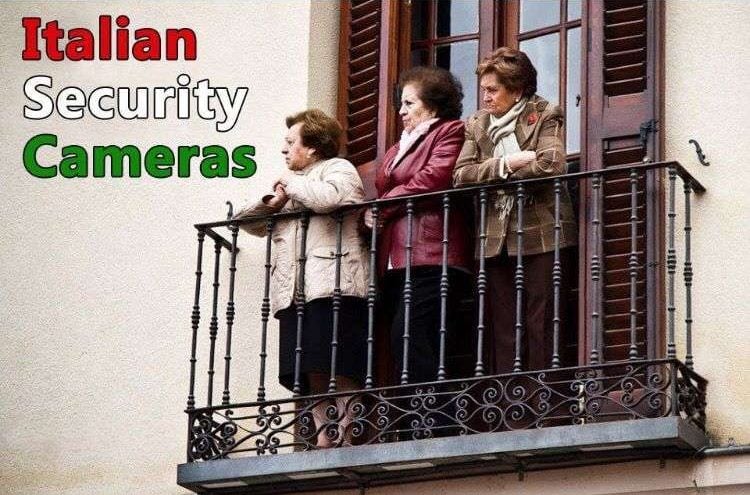Irish Flag vs. Italian Flag: Key Differences Explained
Looking to compare the Irish flag vs. the Italian flag? You’re in the right place!
While they might seem quite alike at first glance, there’s more than meets the eye. Let’s discover the differences between the Irish and Italian flags and unravel the distinct stories and meanings hidden within these symbols.
Irish Flag Vs. Italian Flag: What’s the Difference?

Upon first observation, it’s easy to mistake the Irish and Italian flags for one another, given their striking green and white panels that lie in harmony next to each other.
But, as we look a little closer, the distinguishing feature becomes quite apparent, revealing the distinct personality embodied by each flag.
Starting with the left section, both flags feature a green stripe, but the Italian flag sports a darker green compared to the lighter green present on the Irish flag.
As we move to the right, the Irish flag displays an orange stripe, distinctly different from the red stripe on the Italian flag. This difference in color at the far right end of each flag serves as a clear distinction between the two.
When Did Italy Adopt Its Flag?

Exploring the profound journey of Italy’s beloved official flag, the Tricolore, takes us through significant historical phases that define the nation. Initially, Italy was segmented into various independent states, each boasting its own flag with the ruling family’s distinctive coat of arms.
The notion of a unified Italian flag started to gain momentum after the French Revolutionary War, giving rise to the initial version of a unified Italian flag on October 9, 1796. Introduced by the National Guard of the Transpadane Republic in Lombardy, This flag drew its different colors from the Milanese militia’s uniforms, marking a newfound unity.
Following this, the Cispadane Republic debuted a flag featuring the same colors but arranged horizontally, which later transitioned to the popular vertical stripe layout, earning broad support among Italian nationalists.
In 1848, the flag’s significance was amplified when it was endorsed by King Charles Albert during a battle against Austria, rooting it deeply in Italian history. The journey to the current flag was characterized by several modifications throughout the 19th century, incorporating symbols from the ruling House of Savoy.
In 1946, the inception of the Italian Republic led to the removal of royal symbols, culminating in the modern flag with its recognizable green, white, and red vertical stripes.
Recommended Reading: Explore 21 iconic Italian symbols and their meanings: unveiling the gems of Italy.
Italian Flag Adoption Timeline
Here is a sequential record of the critical milestones in adopting the Italian flag.
- October 9, 1796: The inaugural green-white-red tricolor flag was introduced to the National Guard of the Transpadane Republic in Lombardy.
- January 7, 1797: Using a horizontal design, the Cispadane Republic sanctioned Italy’s first official national flag.
- May 11, 1798: The Cisalpine Republic opted for a vertical arrangement of the different colors.
- 1848: During the Risorgimento, the period steering towards Italian amalgamation, diverse renditions of the Tricolore emerged across Italy.
- 1861: The flag of Sardinia was endorsed as the official banner of the newly established Kingdom of Italy.
- 1946: The modern flag variation has been in circulation since the establishment of the Italian Republic.
- January 1, 1948: The existing flag design received formal recognition.
What Do The Colors Of Italy’s Flag Represent?

Exploring the significance behind the different colors of the esteemed tricolor flag, it becomes apparent that each color narrates a distinct narrative, intricately interwoven with Italy’s rich cultural and historical tapestry.
It is essential to note that no official statement delineates the exact representation of these colors. Yet, the accepted interpretations echo closely with the very essence of Italy, offering deeper insights into its vibrant heritage.
The Italian flag showcases three vertical stripes of equal width, colored green, white, and red. These three colors are interpreted in various ways, embodying different aspects of the Italian heritage and values.
Related Reading: Colors in Italian: Essential Vocabulary & Expressions
Geographical Symbolism
The green hue illustrates Italy’s plains and hills, the white is reminiscent of the snow-capped Alps, and the red is a tribute to the blood sacrificed during the Italian War of Independence.
Philosophical Meaning
The green is a beacon of hope, the white embodies faith, and the red denotes charity.
Community Principles
Green stands for equality, liberty, and aspiration, whereas red echoes love, benevolence, and the sacrifices made during the country’s genesis. The white color steadfastly represents faith.
Many Italians are fond of the poetic notion that the colors portray the nation itself, with the white symbolizing the snowy Alps and other mountainous areas, the green depicting the rural landscapes, and the red commemorating the bloodshed experienced in the various chapters of the nation’s history.
Suggested Reading: 47 best Italian sayings about life: proverbs and quotes unveiled.
When Did Ireland Adopt Its Flag?

Let’s now shift our focus to the scenic land of Ireland. Ireland’s tricolor official flag, adorned with green, white, and orange colors, has a history steeped in gradual evolution, embodying the nation’s journey through several significant milestones.
In the historical annals, the earliest mention of the vertical tricolor flag design with bands of orange, white, and green can be traced back to March 7, 1848. On this day, Thomas Francis Meagher inaugurated its usage in Waterford City, planting the seeds for a symbol that would eventually represent unity and freedom.
However, it wasn’t until the fiery days of the 1916 Easter Rising that the flag began to carve out its place in Irish hearts and minds. It graced the skies, fluttering defiantly over the General Post Office in Dublin. It served as a beacon of hope and resistance during the rebellion.
As Ireland steered towards sovereignty, the Irish Republic adopted this vibrant flag during the tumultuous years of the Irish War of Independence between 1919 and 1921, amplifying its resonance with the Irish people.
The year 1922 saw the flag receiving formal recognition, as it became the emblem of the Irish Free State, marking an important step in its institutional journey. This progression culminated in 1937 when the Constitution of Ireland cemented its status, enshrining it officially as the National Flag, a beacon of the nation’s unity, history, and vibrant cultural tapestry.
Irish Flag Adoption Timeline
Here’s the chronological account of the Irish flag’s evolution.
- March 7, 1848: Thomas Francis Meagher introduces the first recognized vertical tricolor design of orange-white-green.
- 1916: The tricolor is broadly acknowledged as the national flag during the Easter Rising.
- 1919–1921: The Irish Republic adopted the flag during the Irish War of Independence.
- 1922: The flag becomes the official banner of the Irish Free State.
- 1937: The Constitution of Ireland formally ratifies the flag as the National Flag.
What Do The Colors Of Ireland’s Flag Represent?

The colors in the flag of Ireland embody varied facets of the Irish political scene and the aspiration for harmony among individuals with diverse backgrounds. The flag showcases three vertical bands: green, white, and orange. The meanings attributed to these colors are detailed below.
Green
This shade is indicative of Irish Catholics and the movement towards republicanism. Its association with Irish republican sentiments has roots in the 1790s, during which the Society of United Irishmen initiated a revolt to abolish British dominance and establish a sovereign Irish nation.
White
Situated in the middle, the white band epitomizes a sustained ceasefire and the optimism for accord between the conflicting factions, namely the Irish Roman Catholics and Irish Protestants. It mirrors the ambition for solidarity and the integration of communities with varying traditions in Ireland.
Orange
Representing the Irish Protestants and the affiliations of the Orange Order, a Protestant brotherhood, this hue denotes the contingent advocating for British allegiance. It holds significant value for Protestant British loyalists.
Italian Flag vs. Irish Flag: FAQ

What are the main differences between the Italian and Irish flags?
The Italian and Irish flags both sport three vertical bands of equal width. However, the colors present in these bands are distinct.
The Italian flag displays green, white, and red bands, whereas the Irish flag showcases green, white, and orange bands. The stripe furthest to the right on the Italian flag is red, contrasted by the orange stripe in the same position on the Irish flag.
Can the Italian and Irish flags be easily confused?
Though the Italian and Irish flags are similar due to their three vertical stripe arrangement, their color palettes are not identical. The Italian flag features a red section, contrasting with the orange section on the Irish flag.
In comparing the Italian flag vs. the Irish flag, you’ll notice that, when glimpsed quickly or in certain light settings, the hues might seem alike, potentially causing sporadic mix-ups.
Why are the Irish flag and the Italian flag so similar?
The similarity between the Irish and Italian flags is purely accidental, as no significant cultural ties link Ireland and Italy. The two countries conceived their flag designs independently, and the variance in color and symbolism sets each flag apart.
Which flag is similar to Italy’s?
The flag that is similar to the Italian flag is the flag of Mexico; both have green, white, and red stripes, though the Mexican flag features a coat of arms in the center white stripe.
Which flag came first, Italy or Ireland?
The Italian flag came first, officially introduced on January 7, 1797. In contrast, the earliest known version of the Irish flag dates back to March 7, 1848.

What are the Italian flag’s color codes (CMYK, HEX, RGB)?
The color codes for the Italian flag are below.
Green (Verde):
- CMYK: 100, 0, 91, 42
- HEX: #009246
- RGB: (0, 146, 70)
White (Bianco):
- CMYK: 0, 0, 0, 0
- HEX: #FFFFFF
- RGB: (255, 255, 255)
Red (Rosso):
- CMYK: 0, 100, 100, 0
- HEX: #CE2B37
- RGB: (206, 43, 55)
Note: Please cross-verify these color codes, as they might vary slightly based on different sources or specifications.
What are the Irish flag’s color codes (CMYK, HEX, RGB, Pantone)?
Here are the color codes for the Irish flag.
Green:
- CMYK: 100, 0, 59, 73
- HEX: #009A49
- RGB: (0, 154, 73)
White:
- CMYK: 0, 0, 0, 0
- HEX: #FFFFFF
- RGB: (255, 255, 255)
Orange:
- CMYK: 0, 50, 100, 0
- HEX: #FF883E
- RGB: (255, 136, 62)
Please note that these color codes might vary slightly based on different sources or representations, so it’s always best to double-check.
Before You Go…
Captivated by Italian culture? Dive deeper with our article, where you’ll uncover fascinating facts about the Italian language – a journey not to be missed! Click here to continue the adventure.







